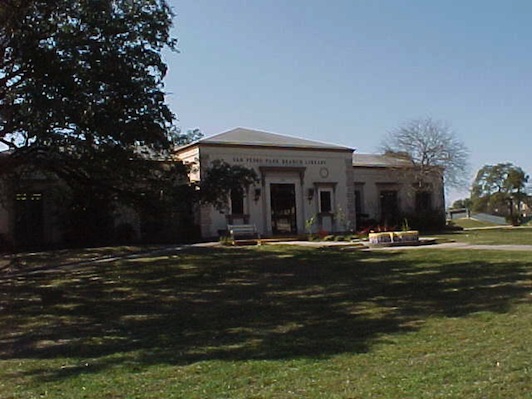Alta Vista Neighborhood Association
Our Information
- Contact List
- Our contact information...
- Newsletter Archive
- Previous Newsletters...
About Us
Alta Vista Neighborhood Association
Neighborhood History
The Alta Vista and Beacon Hill neighborhoods are two of several unique older neighborhoods that evolved during San Antonio's first and greatest expansion, which began in the 1850s and continued with few interruptions until the Great Depression of the 1930s. These neighborhoods grew around the San Antonio Street Railway Trolley lines that originally provided access to historic San Pedro Springs Park. By 1890, electric trolleys were traveling the fixed rail system carrying passengers to San Pedro Springs Park and in the process, significantly influenced the development of the city's first new subdivisions to the north.
Alta Vista and Beacon Hill were among the first "modern" platted subdivisions developed in San Antonio. Alta Vista and Beacon Hill are actually the names of modern-day neighborhood associations and the neighborhoods located within their boundaries. The original platted subdivisions within the boundaries of Alta Vista and Beacon Hill include Laurel Heights Addition, Treasure Hill, Fox's Beacon Hill, Beacon Hill, Beacon Hill Terrace, and North Haven and were developed over three decades from the early 1890s to the late 1920s.
The development of the modern-day Alta Vista and Beacon Hill neighborhoods transformed farm and ranch land located in the hills north of the central district into residential subdivisions with distinctive turn-of-the-century architecture where many prominent San Antonians lived at the turn of the century. The history of this area is unique and very interesting in terms of the modern development of the City of San Antonio. We will present a brief history of the area over the next couple of issues. In this issue we will begin at...
The Beginning
The evolution of the area located roughly between Hildebrand and San Pedro Park, and IH-10 West and San Pedro Avenue may be traced to the turn of the century when today's Alta Vista and Beacon Hill were developed as a part of the first northward expansion of the city of San Antonio.
The San Antonio city limits were established in 1838, and consisted of 36 square mile. North Street (Hildebrand), which is the northern boundary of Alta Vista and Beacon Hill, was also the northern boundary of the city limits from 1838, until 1944. However, prior to 1870, most residences and businesses were located in or near the central district. Several factors significantly influenced the first northward expansion of the city and the development of the present day Alta Vista and Beacon Hill neighborhoods.
First, the city's population grew from slightly over 8,200 persons in 1860, when the city was still a frontier town, to nearly 38,000 persons in 1890. With this magnitude of growth, the pressure to expand outward from the original central city was immense.
Second, the development of San Pedro Park as a recreational destination, may have been one of the most significant influences in the city's first northward expansion, pulling San Antonians northward to enjoy the beautiful park above the city. Reserved as a public park in 1851, San Pedro Park became one of the most popular attractions for San Antonians as early as 1854. The flowing San Pedro Springs helped make the park a place where San Antonians of the 1850s came to relax, and have fun. Outdoor concerts, dances, and political rallies were held regularly at the park. In the 1860s, J.J. Duerler, who leased the park from the city, developed an amusement park with a small museum, zoo, and artificial lakes. As early as 1858, a stable owner by the name of W.D. Cotton was making two trips a day from downtown to the park by horse-drawn carriage.
Recognizing the demand for transportation northward to San Pedro Park, J.J. Duerler established the San Antonio Street Railway Company in 1866, to construct a street railway from downtown to the park. However, Mr. Duerler died in 1874, before he could construct the railway. Colonel Augustus Belknap took over and had constructed the initial line of the San Antonio Street Railway from Main Plaza to San Pedro Park by 1878. Transportation on the line was provided by mule-drawn car. The construction of this line literally opened up the area around San Pedro Park for development.
Third, the arrival of the Galveston, Harrisburg, and San Antonio Railway in 1877, was the final factor that fueled the city's first suburban expansion and the development of the Alta Vista and Beacon Hill neighborhoods. The railway not only provided accessibility to visitors, and new residents, but also provided access to building materials to construct new homes and commercial buildings, as well as new street car lines to meet the demands of the growing population. By 1890, the city's first modern real estate boom was underway and the city's first suburbs were being built.
Historic data sources:
1) San Antonio on Track by Ann Maria Watson, Trinity University, Urban Studies Program, May 1982.
2) U.S. Census historic data for San Antonio, Texas
NEXT MONTH - Alta Vista and Beacon Hill
About our association

Were you aware that the Band Stand at San Pedro Park was once located at the Alamo Plaza downtown?
If you live in the neighborhood, come and join the association. By reading our newsletter you can see that there are a lot of activities that are happening within the area.
Be part of the decision making in your neighborhood. Join the association today.



